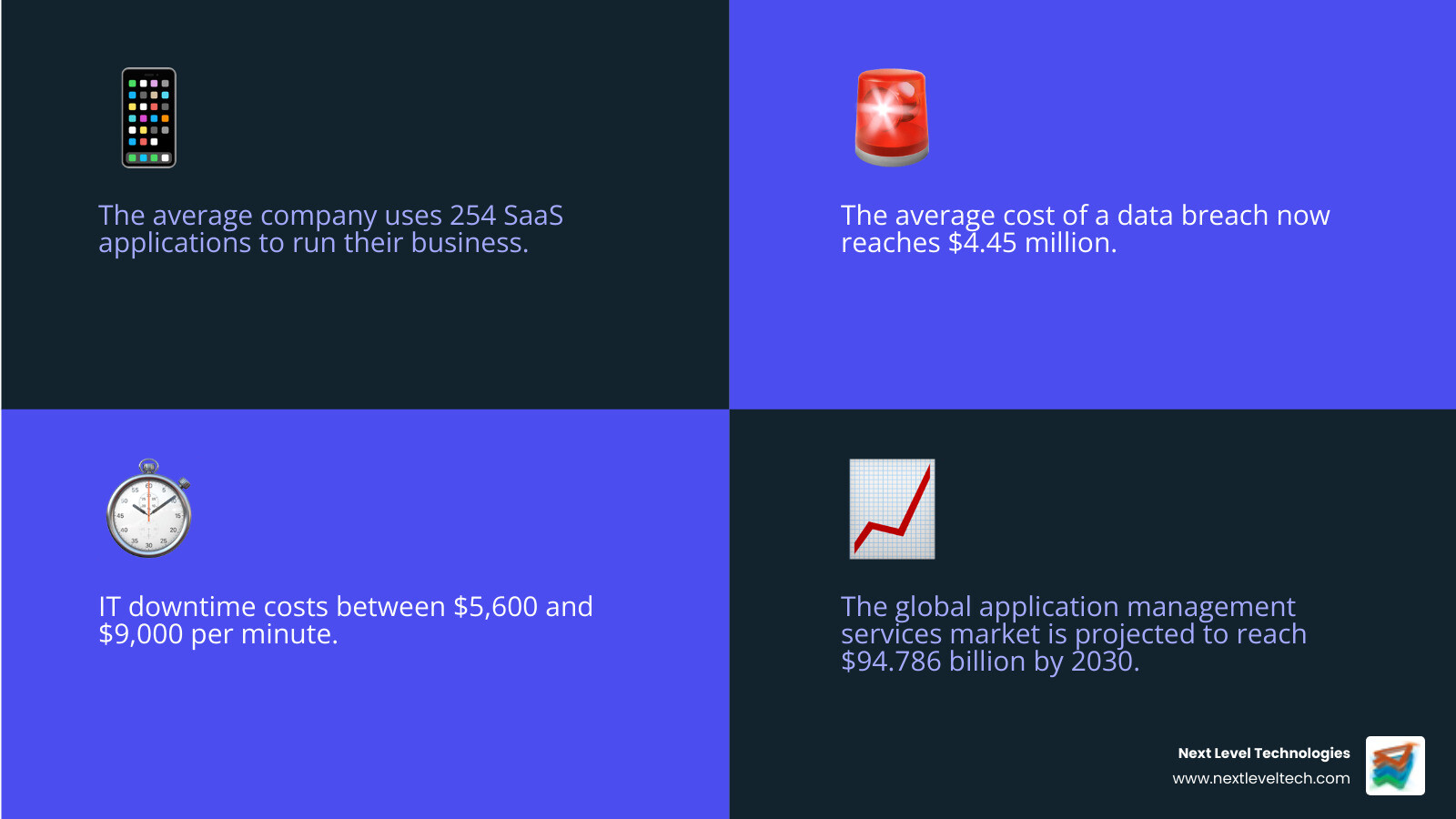App-solutely Essential Mastering IT Application Management
November 12, 2025

Unlock business success with expert it application management. Boost performance, security, and agility effectively.
November 12, 2025

Beyond firewalls: master comprehensive data protection and security. Protect your business from breaches, fines, and cyber threats today.
November 11, 2025

Master networking! Learn about hubs switches bridges and routers, their functions, and how to build a secure, efficient network.
November 7, 2025
November 12, 2025
IT application management is the practice of overseeing software applications throughout their entire lifecycle—from planning and deployment to operation, maintenance, and eventual retirement—ensuring they perform optimally, remain secure, and support business objectives.
Quick Definition:
In today's digital landscape, the average company uses 254 SaaS applications to run their business. That's not just a technology challenge—it's a strategic imperative. Every application represents a potential point of failure, a security vulnerability, or a productivity bottleneck if not managed properly.
The stakes are high. IT downtime costs between $5,600 and $9,000 per minute, and the average data breach now reaches $4.45 million. For mid-sized businesses dealing with outdated technology and frequent system disruptions, effective application management isn't optional—it's the backbone of operational stability.
Application management transforms software from a necessary expense into a business enabler. It's about ensuring your critical applications are available when you need them, performing at peak efficiency, and protected against evolving threats. This means proactive monitoring instead of reactive firefighting, strategic planning instead of crisis management, and predictable costs instead of surprise expenses.
I'm Steve Payerle, President of Next Level Technologies, and I've spent over 15 years helping businesses in Columbus, Ohio and Charleston, WV master IT application management through comprehensive managed services and cybersecurity solutions. Our team's extensive technical training and hands-on experience have shown us that the difference between businesses that thrive and those that merely survive often comes down to how well they manage their application ecosystem.

Think of your business as a symphony orchestra. Each application is an instrument, and when they're all tuned and playing together, the result is beautiful. But if even one instrument is out of tune or a musician misses their cue, the entire performance suffers. That's the reality of modern business technology—and it's why IT application management isn't just important, it's absolutely essential.

Effective IT application management is crucial for keeping your business running smoothly. It touches everything from your bottom line to your customers' experience.
Application performance directly impacts your business, as users notice every delay, error, or crash. Maximizing performance and availability involves:
Cyber threats are more sophisticated than ever, making application security a critical component of IT application management. Our strategy is built on several key pillars:
Our teams' extensive cybersecurity training is applied to every engagement, ensuring your business is protected. Learn more about our comprehensive IT security services.
Think of IT application management as caring for a garden. You don't just plant seeds and walk away—you nurture each plant through every season. Similarly, we don't just launch applications and hope for the best. We guide them through their entire journey, ensuring they stay healthy, productive, and aligned with your business needs.
At Next Level Technologies, we follow the ITIL framework, which defines the core objective of application management as overseeing applications throughout their lifecycle. Our teams in Columbus, OH and Charleston, WV bring extensive technical training to this work, ensuring every application performs well and meets governance standards.

Gartner defines Application Management as an ongoing activity, not a one-time project. It's the difference between building a house and maintaining a home.
The application lifecycle is a complete circle. Effective IT application management means staying engaged through every phase:
Understanding these stages helps you see the IT asset life cycle as a complete journey, not isolated events.
It's helpful to distinguish between Application Management (AM) and Application Portfolio Management (APM). Think of your applications as a fleet of vehicles:
While AM focuses on the health of single applications, APM assesses the business value of the entire portfolio, connecting closely with IT asset management to ensure every tool contributes to your goals. At Next Level Technologies, our extensive technical experience allows us to excel at both, ensuring your applications run at peak performance while optimizing your overall technology investment.
Think of IT application management as tending a garden. Success comes from following proven practices that keep applications healthy, secure, and productive. Over years of working with businesses in Columbus, OH, and Charleston, WV, we've identified several best practices:
Robust ITSM software can help centralize these practices and ensure consistency.
Automation isn't about replacing people; it's about freeing them to focus on strategic work. In IT application management, automation is a game-changer:
Security isn't an add-on; it's a foundational element of IT application management. With data breaches costing millions, a layered defense is essential. Our teams in Columbus and Charleston apply their extensive cybersecurity training to implement these best practices:

These practices are vital for maintaining cybersecurity compliance services and protecting your business.
The world of IT application management is constantly evolving with the rise of DevOps and cloud-native technologies. These shifts enable greater business agility and a better user experience, but also create challenges like integrating legacy systems and finding specialized talent. Our teams in Columbus, OH, and Charleston, WV, leverage continuous technical education and cybersecurity training to help businesses steer this complexity, especially when managing cloud applications.
Effective IT application management requires collaboration across several key roles:
Using a clear model like RACI ensures smooth communication. When these stakeholders collaborate, application management becomes a powerful engine for business success.
Many businesses find their internal teams stretched thin by an increasingly complex application landscape. That's when partnering with an Application Management Services (AMS) provider makes sense. The global AMS market is projected to reach $94.786 billion by 2030, reflecting this growing need.
Consider AMS when you face:
As one of the leading managed IT services companies, we extend your team with the specialized support needed to manage today's complex environments.
An application manager acts as the strategic overseer of an organization's software applications. They manage the entire application lifecycle, from deployment to retirement, ensuring each one performs optimally, remains secure, and aligns with business goals. Their responsibilities include monitoring performance, coordinating issue resolution with developers and IT teams, managing security and upgrades, and making strategic decisions about the application portfolio to control costs and improve user satisfaction.
The key difference is focus and duration. The Software Development Lifecycle (SDLC) is a finite project focused on building new software, covering phases like design, coding, and testing. IT application management (AM) is an ongoing, long-term process focused on operating that software throughout its entire useful life. AM begins after the initial deployment and includes everything from daily monitoring, maintenance, and user support to security management and eventual decommissioning. In short, SDLC creates the application; AM ensures it delivers value for years to come.
Application Management Services (AMS) are comprehensive solutions that offload the operational burden of managing software. A provider like Next Level Technologies typically includes:
The goal is to free your internal team to focus on strategic initiatives while experts ensure your applications are reliable and secure.
IT application management is more than a checklist item; it's the engine that keeps your business running smoothly and securely. With companies relying on hundreds of applications and downtime costing thousands per minute, a proactive approach is no longer optional. Effective management prevents problems, protects data, and open ups opportunities for growth.
As we've covered, this means shifting from reactive firefighting to strategic oversight. The result is better performance, tighter security, and a team focused on innovation instead of technical issues.
However, managing a complex application ecosystem requires specialized expertise. Many businesses find that their internal teams are stretched too thin. That's where a trusted partner comes in.
At Next Level Technologies, we serve as an extension of your team for businesses in Columbus, OH, and Charleston, WV. Our extensive technical and cybersecurity training ensures your applications are both high-performing and secure. We handle the complexities of application management so you can focus on your core business.
If you're ready to turn your applications into a competitive advantage, we're here to help.
Beyond firewalls: master comprehensive data protection and security. Protect your business from breaches, fines, and cyber threats today.
November 11, 2025
Master networking! Learn about hubs switches bridges and routers, their functions, and how to build a secure, efficient network.
November 7, 2025
Next Level Technologies was founded to provide a better alternative to traditional computer repair and ‘break/fix’ services. Headquartered in Columbus, Ohio since 2009, the company has been helping it’s clients transform their organizations through smart, efficient, and surprisingly cost-effective IT solutions.
